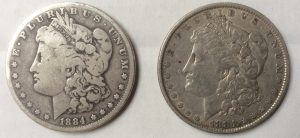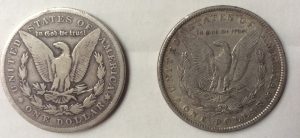The 1884 dollar was in good (G-4) condition with a rim ding while the 1881 coin could pass for an extra fine (XF). When the person behind the cases said that she would sell the coins for $20 each, I added them to growing list of items I was buying. JJ was jealous.
JJ considers himself a hoarder and collector. He likes to find Morgan dollars and hoards them. During our conversation, he said that he hoards all pre-1965 coins regardless of type and condition. As a result, we ended up discussing collecting “modern” versus “classic” coins.
JJ and I are about the same age. We grew up with clad coinage but continued to find silver coins in pocket change until the early 1970s. We filled blue folders from the pocket change we were able to find in our father’s pockets and we have our respective first folders of Lincoln cents. Even though the modern era has been going on for 53 years, there are a lot of people like JJ who gives these coins little to no respect.
There are very few rare coins to be found in circulation. Gone are the days when the 1914-D, 1922 no D, and the 1955 “Spoiled” Lincoln cents were circulation finds. Even with the conflicts around the world, there are no shortages or special production coins that caused the rarities of the 1921 half-dollars, especially since half dollars rarely circulate. Aside from being a sign of how the U.S. Mint has improved its processes, it is also a function of the better economy where there is a need to produce billions of coins every year. We do not want that situation to change!During the first few years of the blog, I had provided extensive coverage and review of the State Quarters series. At the time, it was a novel idea that involved everyone as the states held competitions to decide how they will be represented forever. Some designs were really special and showed off the historical importance of their state. Others had great designs. Then there were those that were so ugly one could be excused if they were removed from their collections. The problem is that the state quarters were not rare (Philadelphia produced over 1 billion Virginia quarters in 1999) and the hucksters inflated their future value, especially on the television shopping networks turning people off to the hobby.
I have not said much about the America the Beautiful Quarter series. There seems to be a lack of interest in a lot of places. Collectors have shown a fatigue in yet another series and the public has not been involved with the designs as they were with the state quarters. In fact, the U.S. Mint, National Park Service and U.S. Forestry Service worked together to make the decision as to what National Parks or National Forests to feature without involving the public.
Of course, when you do not involve the public you get the infighting between the Citizens Coinage Advisory Committee and U.S. Commission of Fine Arts regarding the design. We see the dance between the two as just annoying while the public sees more government bureaucracy causing problems.
It is possible that the dealers have been talking down modern United States coinage because of their business concerns. However, there are companies that are now making a good living fulfilling the needs of collectors putting together sets and selling non-circulating legal tender (NCLT) coins. While I think some of the coins are gimmicks, these companies are doing well selling the colored and other coins from the Royal Canadian Mint, Royal Australian Mint, and the countries that have had the New Zealand Mint produce their coins.
Just because I do not like those coins does not diminish their value as numismatic collectibles. Even though I will not collect many of these coins, there is nothing wrong with those who do. Maybe if the hobby stops disparaging modern and these alternative types of NCLT coinage it will inspire more collectors to use them as a gateway into the hobby. It would not hurt to try!



